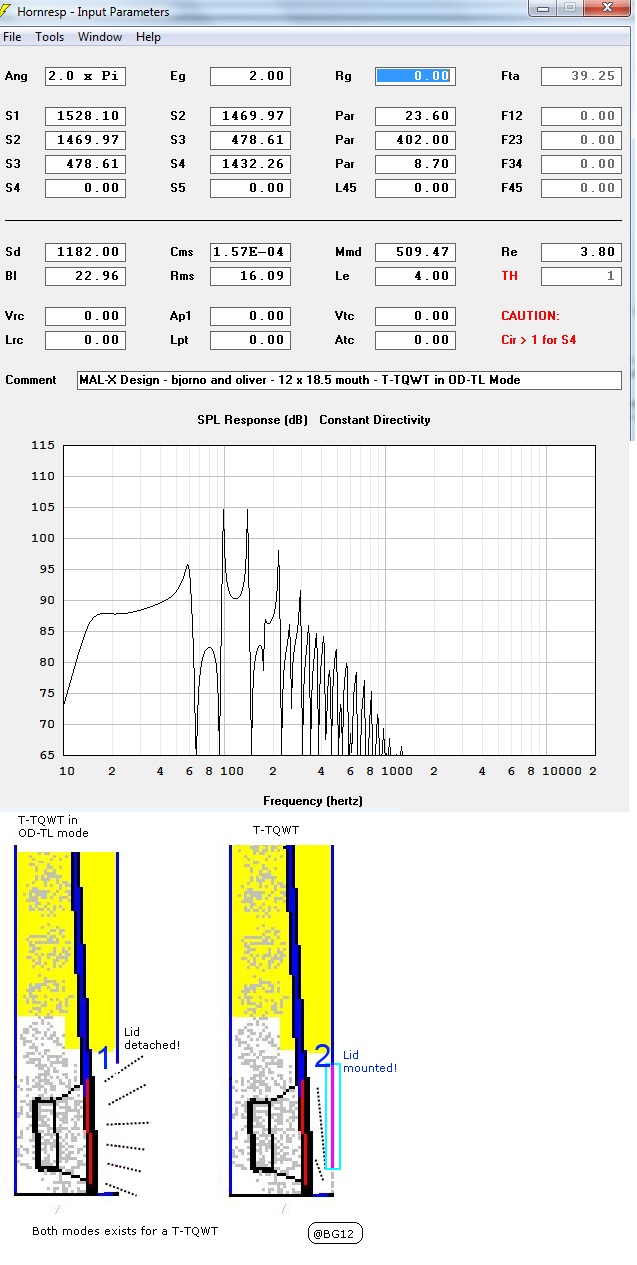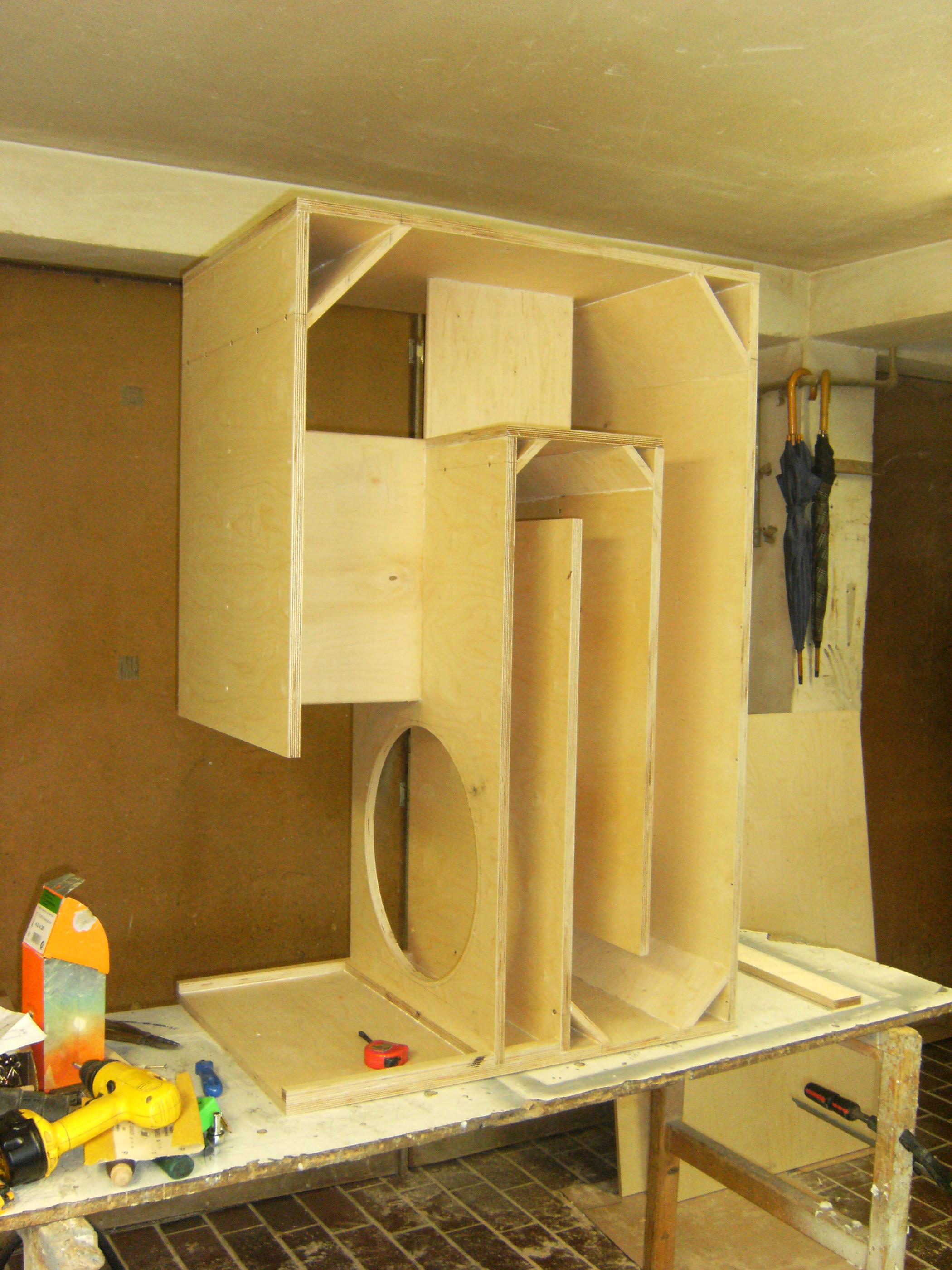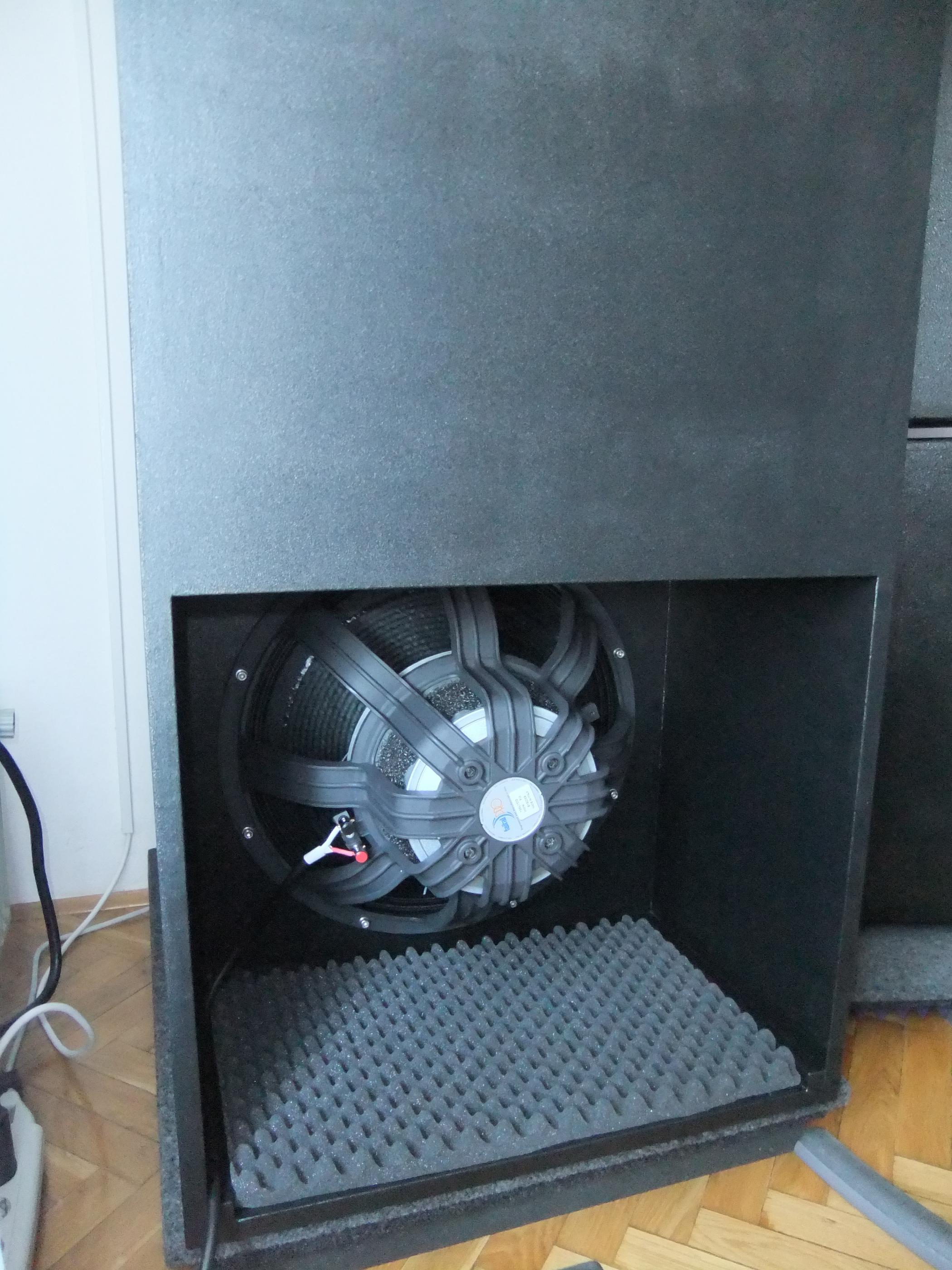Hi NWCgrad,
Here is the 2nd attempt at bjorno's T-TQWT for the Maelstrom 18", as we discussed, I tried to get as close as I can to the simulation values (this time not adding any additional volume for braces or stuffing), particularly for the L23 and S2/S3 dimensions, the rest flows from there assuming a constant expansion angle.
I hope this will give you a starting point from which to decide how to put the puzzle together.
Regards,
Oliver,
Can you attach a screen shot of the Hornresp input parameters, the numbers seem a little different than bjorno's (in particular the diameter of S4 is a little larger). I am trying to put togather a summation of the final design for when I start my build thread next summer. I cannot wait to get started!
Thanks again to you and bjorno for this great design.
Hi again,
Haven't forgotten about you, I made a mistake in Post #71, 1st paragraph: instead of saying:"...any additional volume...", it should say: "...minimal additional volume...".
So, you are correct the numbers are a little bit different from bjorno's; but he did his in Hornresp, and mine are in wood (drawing).
When you plot out the dimensions from bjorno's simulation you will notice that there are minor angle differences between the three sections (not that this matters substantially); when building a box it is easier to stay with a specific angle, in this case I choose an even 3 degrees throughout, resulting in a slightly larger duct volume. I stopped at this point as I feel we are definitely close enough, and everytime you change, e.g.: the angle, you have to change all the box dimensions, which is easy in a simulations, but not in "wood".
The whole S3/S4/L34 section depends on where you locate the terminus. As to the S4 diameter-for a circular terminus located right in front of the center of the driver: where it says L34=3.487" it should be L34=3.4223", at a 3 degree angle, the equivalent duct height should be 3.8306", and the area S4=70.866in^2 (width being 18.5"), or S4=457.2cm^2. For an area of 70.866in^2 I get a diameter of 9.5".
Anyway, I'll attach a Hornresp Input reflecting the dimensions in the drawing, and a comparison between the tubes.
Regards,
Haven't forgotten about you, I made a mistake in Post #71, 1st paragraph: instead of saying:"...any additional volume...", it should say: "...minimal additional volume...".
So, you are correct the numbers are a little bit different from bjorno's; but he did his in Hornresp, and mine are in wood (drawing).
When you plot out the dimensions from bjorno's simulation you will notice that there are minor angle differences between the three sections (not that this matters substantially); when building a box it is easier to stay with a specific angle, in this case I choose an even 3 degrees throughout, resulting in a slightly larger duct volume. I stopped at this point as I feel we are definitely close enough, and everytime you change, e.g.: the angle, you have to change all the box dimensions, which is easy in a simulations, but not in "wood".
The whole S3/S4/L34 section depends on where you locate the terminus. As to the S4 diameter-for a circular terminus located right in front of the center of the driver: where it says L34=3.487" it should be L34=3.4223", at a 3 degree angle, the equivalent duct height should be 3.8306", and the area S4=70.866in^2 (width being 18.5"), or S4=457.2cm^2. For an area of 70.866in^2 I get a diameter of 9.5".
Anyway, I'll attach a Hornresp Input reflecting the dimensions in the drawing, and a comparison between the tubes.
Regards,
Attachments
I was reading another post where Bjorno was showing that a T-TQWT can be converted into a OD-TL by removing the "lid" (see http://www.diyaudio.com/forums/subwoofers/213821-subwoofer-lt.html)
I tried to see what it would to do the latest iteration of this design by calculating an area of 12" x 18.5" for S4 (gives an error reading so I am missing something critical). Does not cahnge the response hardly at all, again I must be missing something.
I tried to see what it would to do the latest iteration of this design by calculating an area of 12" x 18.5" for S4 (gives an error reading so I am missing something critical). Does not cahnge the response hardly at all, again I must be missing something.
Attachments
I was reading another post where Bjorno was showing that a T-TQWT can be converted into a OD-TL by removing the "lid" (see http://www.diyaudio.com/forums/subwoofers/213821-subwoofer-lt.html)
I tried to see what it would to do the latest iteration of this design by calculating an area of 12" x 18.5" for S4 (gives an error reading so I am missing something critical). Does not cahnge the response hardly at all, again I must be missing something.
When you just increase the mouth size, you're making the mouth bigger, but the mouth remains below/after the driver. The implication of the OD-TL is that you remove a lid which is so large that the sound coming through the maze exits the box before it sums with the driver's front output. It still sums obviously, but it's no longer summing internally.
To simulate this, you need to get rid of L34 entirely (the path from the driver to the opening), and also shorten L23 by about 25 cm (at least half the driver diameter) to account for a lid that covers the entire driver being removed. and at this point since it is no longer summing internally, but the driver is firing out into open air, the horn type needs to be changed to OD (OD because the driver is attached between L12 and L23, and not all the way at the beginning). After that, just make sure you combine the outputs, and you have something that looks like this (grey trace is with the lid still on, original sim):

This

is no different than this, other than it is a positive tapered TH.
http://www.diyaudio.com/forums/subwoofers/210339-tapped-horn-th-121-build-9.html


I still say the whole front panel has to go to be a true OD-TL, like this. Disregard the top lefthand corner since the design is a full range cabinet. It took me awhile to find a true OD-TL where the port exits the same direction as the woofer.
http://www.diyaudio.com/forums/subwoofers/70698-transmission-line-add-ons.html

is no different than this, other than it is a positive tapered TH.
http://www.diyaudio.com/forums/subwoofers/210339-tapped-horn-th-121-build-9.html


I still say the whole front panel has to go to be a true OD-TL, like this. Disregard the top lefthand corner since the design is a full range cabinet. It took me awhile to find a true OD-TL where the port exits the same direction as the woofer.
http://www.diyaudio.com/forums/subwoofers/70698-transmission-line-add-ons.html
An externally hosted image should be here but it was not working when we last tested it.
Last edited:
To me, that's still a ttqwt with a bigger mouth. Now if that whole front panel is removed, then I can see it as a tl.
I believe I misspoke, bjorno indicated it is a t-tqwt operating in OD-TL mode, which after reading the responses from you and jwmbro Iam thinking is not the same as a true OD-TL.
Increasing the mouth seems to trade the deeperst extension for a little more sensitivity above 20 Hz, which I had forgotten than bjorno indicated much earlier in this thread.
I think I will stick with the finalized plan by Oliver, just thought I would see if I could make the mouth big enough to add the driver without the need for a lid which introduces a potential air leak.
I believe I misspoke, bjorno indicated it is a t-tqwt operating in OD-TL mode, which after reading the responses from you and jwmbro Iam thinking is not the same as a true OD-TL.
Increasing the mouth seems to trade the deeperst extension for a little more sensitivity above 20 Hz, which I had forgotten than bjorno indicated much earlier in this thread.
I think I will stick with the finalized plan by Oliver, just thought I would see if I could make the mouth big enough to add the driver without the need for a lid which introduces a potential air leak.
I'm sticking a fork in the design! Calling it good to go on my end, as soon as I get back to the US will start to build the enclosure (hopefully by Aug 2013). Seems like the more I try to learn, the less I know. Over the past few months I have been reading pretty much all the threads on this site (plus AVSforum). It is becoming an obsession.
I have modeled other common drivers in the enclosure, not as flat through the area of interest, but with a parametric eq I may be able to add a second enclosure (definately overkill for HT, but that is the point).
I completed a bunch of camparisons with Bjorno's orginal design and the one finalized by Oliver (see the two attachments). Both look exceptional to my untrained eye. Hornresp is addictive. In a 1 pi space, looks like 77.46 volts (1000 watts/4 ohms) will yield over 125 dB at 15 Hz at 1 M. Based on cone excursion, I may need an HPF at ~12 Hz.
Original Goal: Maximal SPL to as low as possible, sub will be used for ULF augementation of 2 to 4 LAB-12 based subs (http://www.diyaudio.com/forums/subwoofers/216201-t-tqwp-design-eminence-lab-12-a.html), which were also the product of the Bjorno/Oliver design team. I plan to low pass filter the MAL-X at 30-40 Hz, will use REW to determine the best upper limit. For music, the MAL-X will not contribute. I expect the system matching will require a lot of measure, move, measure iterations, I have both a miniDSP (I do not really like it, but the software is cool) and a Behringer DSP1124P. Should be able to dial in the accurate sound I am looking, for with or without a house curve.
Room: Dedicated music/home theater in basement of townhome, very open floor plan so need to fill a large space. Once I retire from navy and settle down, will design an optimal space.
I would once again like to thank everyone on DIYaudio, you guys are awesome!!!!
Attachments
Last edited:
When you just increase the mouth size, you're making the mouth bigger, but the mouth remains below/after the driver. The implication of the OD-TL is that you remove a lid which is so large that the sound coming through the maze exits the box before it sums with the driver's front output. It still sums obviously, but it's no longer summing internally.
To simulate this, you need to get rid of L34 entirely (the path from the driver to the opening), and also shorten L23 by about 25 cm (at least half the driver diameter) to account for a lid that covers the entire driver being removed. and at this point since it is no longer summing internally, but the driver is firing out into open air, the horn type needs to be changed to OD (OD because the driver is attached between L12 and L23, and not all the way at the beginning). After that, just make sure you combine the outputs, and you have something that looks like this (grey trace is with the lid still on, original sim):

Hi jwmbro,
I appreciate your explanation of what must be considered when turning a T-TQWT(T-QWP) into OD-mode.
Adding the fact that in OD-mode the in room FR performance is a sum of the driver and terminus(port) contributions taking place in the far-field and is different for a T-TQWT terminus that acts like a pressure point-source.
Further, in OD-TL mode, any surrounding furnitures would have more impact on the resulting room-FR opposed to a T-TQWT that show a very benign influence from that type of close boundaries.
Adding a picture showing T-TQWT to OD-TL transformation.
b
Attachments
Hi jwmbro,
I appreciate your explanation of what must be considered when turning a T-TQWT(T-QWP) into OD-mode.
Adding the fact that in OD-mode the in room FR performance is a sum of the driver and terminus(port) contributions taking place in the far-field and is different for a T-TQWT terminus that acts like a pressure point-source.
Further, in OD-TL mode, any surrounding furnitures would have more impact on the resulting room-FR opposed to a T-TQWT that show a very benign influence from that type of close boundaries.
Adding a picture showing T-TQWT to OD-TL transformation.
b
Bjorno, thanks for the explantion. Since I need a lid to install the driver I can give both versons a go.
THANK YOU!!!! You have been of great value to my education in subwoofer design. I will stick with my day job as a microbiologist, it seems easier than speaker design.
Hi,
My ¨pictorial' comments of the in #89 posted: 'Bjornos Original compared to Olivers Final - SPL Data by frequency.jpg'...
I designed the single folded T-TQWT to preserve the maximum available RMS Power capability in mind while not exceeding typical max. Rec. Port Air Velocities..
Anyhow...I would stick with the tb46 design...trading SPL for better BW is IMO always a better idea for a main 'home' sub.
b
My ¨pictorial' comments of the in #89 posted: 'Bjornos Original compared to Olivers Final - SPL Data by frequency.jpg'...
I designed the single folded T-TQWT to preserve the maximum available RMS Power capability in mind while not exceeding typical max. Rec. Port Air Velocities..
Anyhow...I would stick with the tb46 design...trading SPL for better BW is IMO always a better idea for a main 'home' sub.
b
Attachments
- Status
- This old topic is closed. If you want to reopen this topic, contact a moderator using the "Report Post" button.
- Home
- Loudspeakers
- Subwoofers
- TH or T-TQWP or ????






